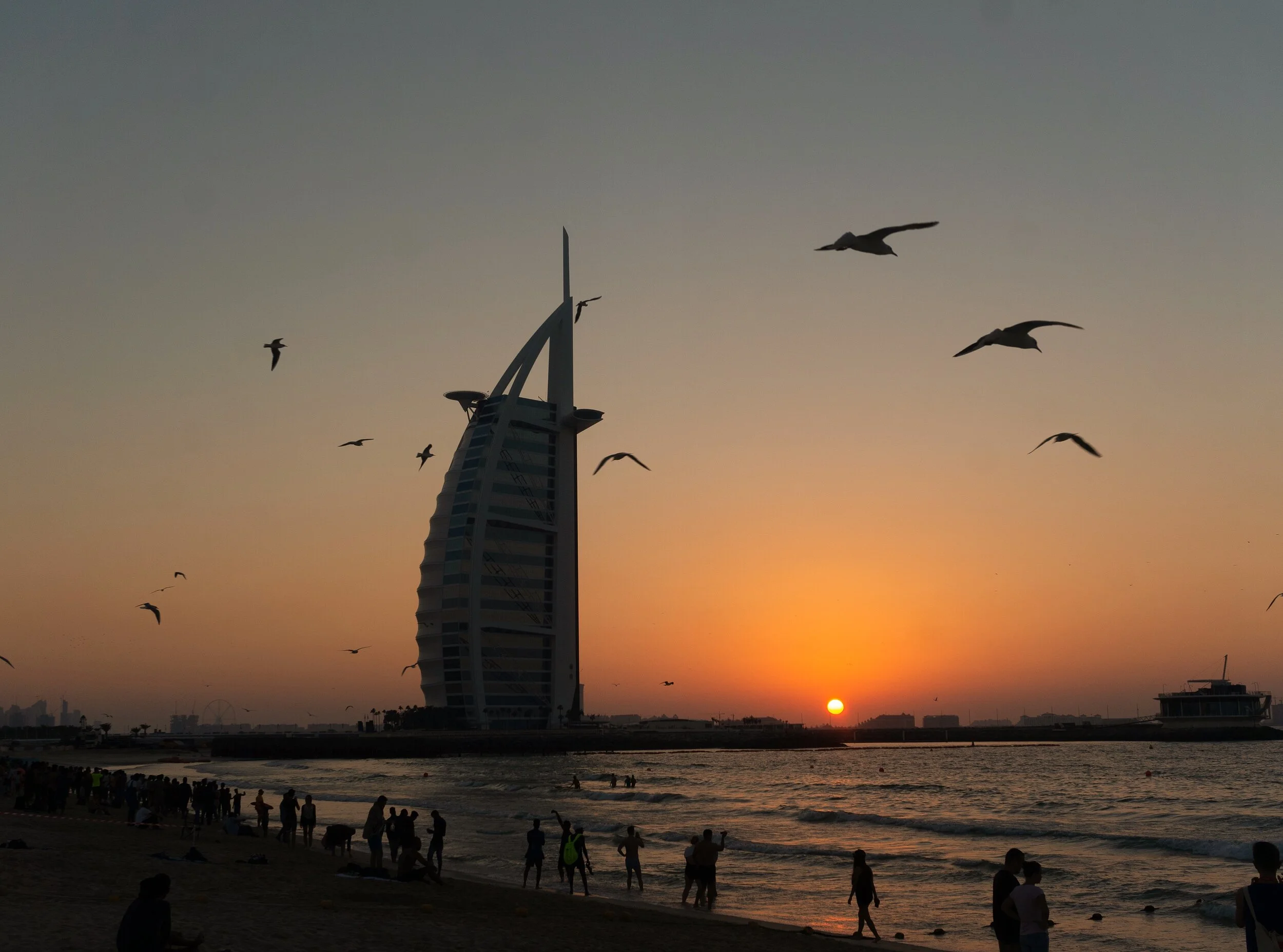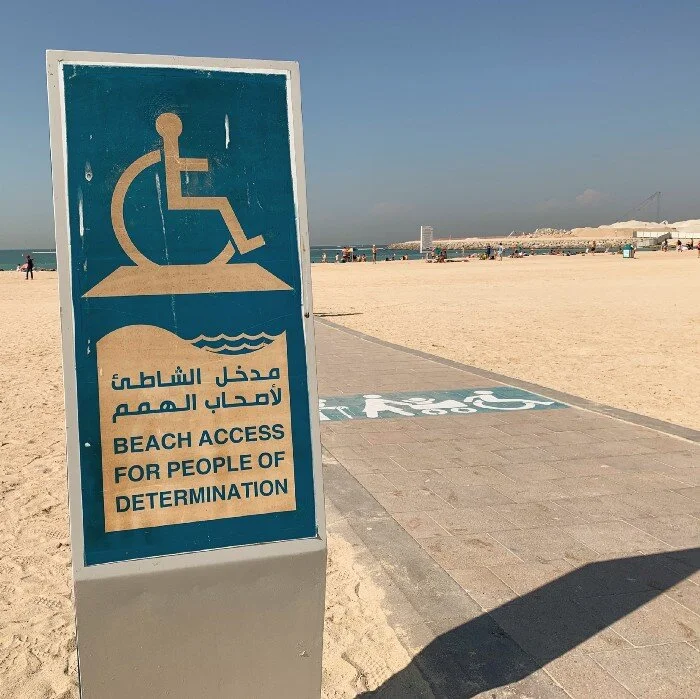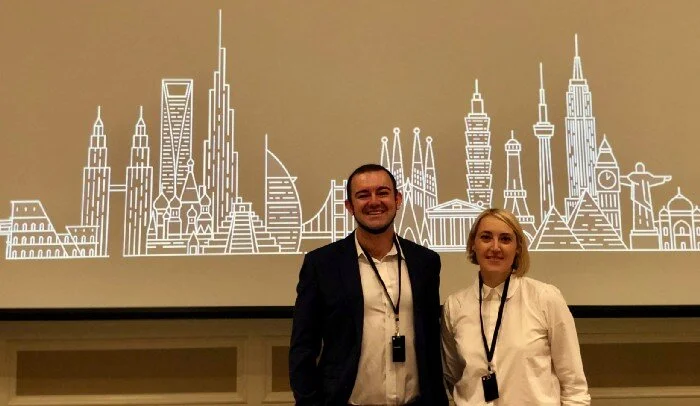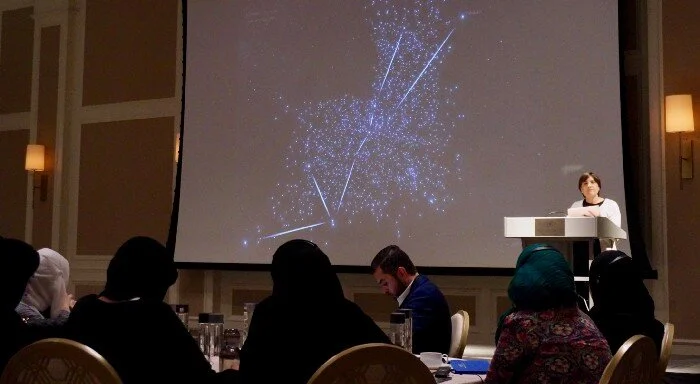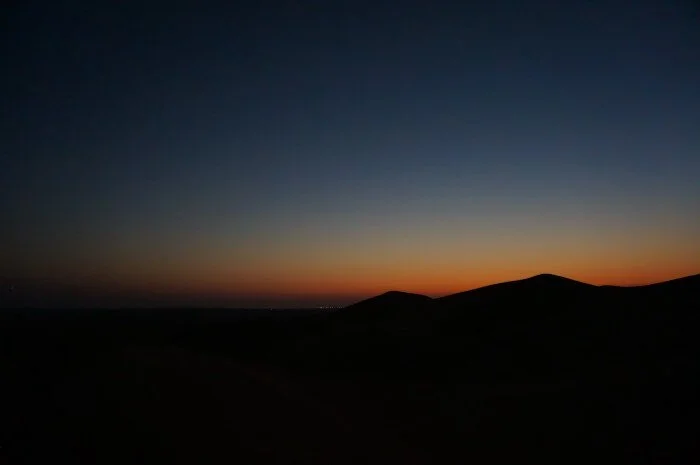I have just returned from a week in Dubai, presenting at a summit on accessibility and inclusion. I was fortunate to be invited to present the closing keynote on both days of the summit, as well as to collaboratively deliver practical workshops across the event. Undoubtedly the most enriching part of the experience was the opportunity to collaborate with peers who I have met in other parts of the world previously, for us to find ourselves in Dubai and to share the work we have built up through our practice across the areas of special education, accessibility and universal design. In this brief summary I will recount some of what I spoke about at the event, as well as what was shared by my colleagues, and other experiences that connect with the outcomes of the summit.
Photo above of a beach with a sign that reads, ‘Beach Access for People of Determination’ next to a paved pathway that leads from the street, through the beach, to the water.
In recent times the government of the United Arab Emirates passed a policy aimed at empowering citizens with special needs, who are now referred to in the UAE as ‘people of determination’. This policy has far reaching goals, from making all parts of the physical and social landscape of the UAE accessible to all citizens, through to supporting all educational institutions to take on increasingly inclusive practices to best reach all students. In the photo above there is a beach with a sign on it that says ‘Beach access for people of determination’. Beside the sign is a paved pathway that leads all the way from the street, through the beach and to the water, where waterproof flooring allows people to safely navigate where the waves hit the beach on firm accessible foundations. You might see painted on the pathway above there are graphics of an elderly citizen walking, a parent pushing a pram, and an individual in a wheelchair. Universal designs — you could include somebody pulling a bag on wheels down the pathway, or someone with sensory aversions to sand walking along it, or any other individual option for using a design choice such as this.
Photo above of two educators, Craig Smith and Karen Hart, wearing professional attire and lanyards, standing in front of a projection screen displaying an outline of famous buildings from around the world.
At the summit we had a chance to hear from speakers from around the world, all sharing their own slice of universal design expertise. Daniela Rubio, born blind, now a global educator, lecturer and consultant, delivered a spellbinding opening demonstration of how she uses her iPad with VoiceOver to engage in her passion — astronomy. Now, I don’t know what your experience is with astronomy, but it might seem to you as though astronomy is something that requires vision to fully engage with. Not so, demonstrated Daniela, showing us all that there is so much more to what we think we see — she was able to navigate constellations with her iPad, zoom in on star systems and planets, and listen to them, not through audio description but through the music of the spheres, the subtle auditory markers that identify one set of stars from the next. It was an absolute thing of beauty to experience. Afterwards, an educator came up to Daniela and said that he felt his life could be divided into two parts — before witnessing Daniela’s talk, and afterwards. He said he wanted to devote his life to developing apps that could further build on what Daniela showed was possible, to enhance the lives of all citizens. It was a very special moment.
Photo above of Daniela Rubio presenting in front of a projection screen displaying a constellation of bright stars while an audience watches and listens to her.
We heard too from local educators such as Fatma Al Qassimi, the Manager of Accessibility Office at Zayed University, who shared her own personal journey with polio and how it lead her to create a state of the art innovation space within the university that supports all students to access the curriculum in increasingly personalised ways. I had the opportunity as well to work with Karen Hart, an accessibility consultant, designer and developer who shared her unique strategies in practical workshops on how to meet a wide range of cognitive processing needs in the classroom through helping students to individually tailor the tools they use to access their education. We learned about tools that address visual processing needs such as those encompassed in Dyslexia, as well as other cognitive and sensory processing needs.
Photo above of educator Karen Hart standing behind a podium, in front of a projection screen showing a news article on an iPad that has been put into Reader mode. Text from the article reads ‘National policy empowers people of determination’.
For my own contribution to the summit, I discussed a few key things — the reason it is beneficial to tap into the passion that our students have for their interests and the natural strengths they demonstrate in their daily lives; the ways to stay connected with best practice around the world; and how to actively contribute to the development of innovation in special education. I shared stories of my students and the successes they have experienced across their lives when they were able to harness the natural strengths they demonstrated to us, how we were able to help them establish goals that allowed these strengths to further flourish and, in the process, to help support the areas they needed extra help in. I shared examples of how student interests can be used to motivate and excite the imaginations of our students, to help them realise who they are as learners and as humans, and how this has allowed them to connect with others and to collaborate in ways that still surprise us every day. I talked about ‘sandpit’ play sessions, where teachers play with each other for the day, creating ideas for learning experiences and testing them out on each other, in the classroom, outside on the playground, in the garden, on the trampoline, everywhere. I talked about design thinking and hackathons that teachers can run, both internally in schools but also the ways to use these formats to crowdsource sharing from students, families and teachers in person and online, and to bring all of the learnings from these strategies back into the school to help improve student outcomes. And, more than anything, I talked about how we know when we are on the right track, when we see real outcomes from our students, not just across academic portfolios or individually tracked goals, but in the real, messy, complicated human successes that can’t be tracked in any other way than through knowing your students really, really well.
Photo above of Craig Smith standing in front of a projection screen that reads ‘Universal Learning’ Newcastle, Australia. Craig Smith. National Coordinator, Positive Partnerships. Autism Spectrum Australia. Twitter logo, @wrenasmir.
I had the pleasure of chatting and learning from so many educators not only from the United Arab Emirates but also from neighbouring countries. Two educators from Oman shared with me sensory strategies they employ in the classroom to help regulate the needs of a student on the autism spectrum, and it felt like I was sitting back home in Australia sharing ideas with colleagues. I asked if they knew about the TEACCH program, structured teaching. They said of course, and then showed me the visual engagement strategies they use to employ structured teaching in their classroom. They shared occupational therapy strategies, augmentative and assistive communication practices, ways of displaying timetables in the classroom, and I realised, yet again, just how universal good teaching practices are in our special education space. I have been privileged to witness the same when sharing teaching ideas with special educators in Shanghai, in Johannesburg, in Christchurch, in Singapore, in Wee Waa — when educators are passionate about genuinely reaching all learners, about getting to know each student on an individual level, using tools to gather information about the child, what they are passionate about, how they best learn, where they can go from here to flourish even further, and then put in the time to allow this to happen, that’s when you know you are part of a global community of dedicated professionals who are building universal practices that will hopefully contribute to broader societal outcomes as the fruits of this work take bloom.
Photo above of the Arabian Desert after the sun has set. The sand dunes are black silhouettes, with only a soft glow of light rising above in a transition from orange to deep blue.
Out of my time in Dubai I was able to grow professional relationships with colleagues who inspired me to reach even further towards these outcomes. We came up with ideas and points of collaboration that are still bouncing around in my mind, quickly finding their way onto eagerly scribed notes across notepads and devices. I can’t wait to follow up on these new ideas to share on our professional journey moving forward, always challenging ourselves to build forever evolving opportunities for our students to become who they want to be.
December 2018.
